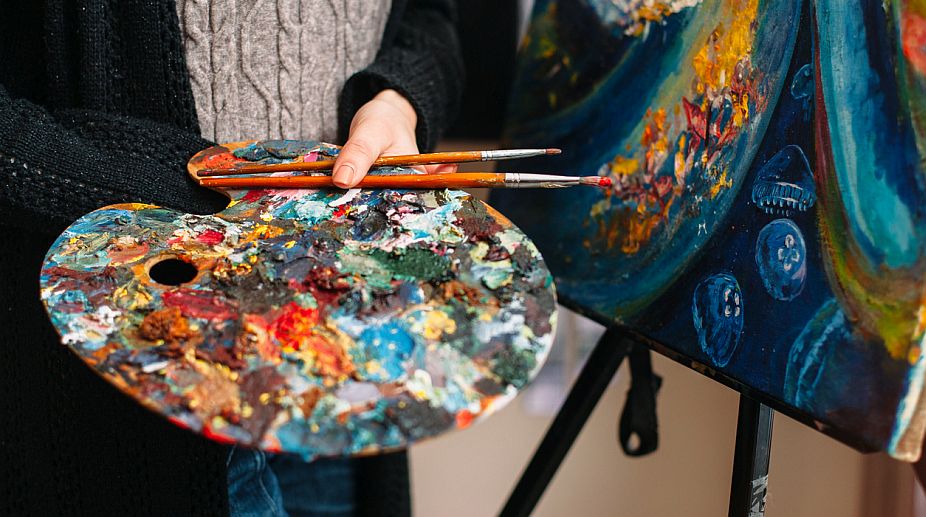Confidently facing the possibility of failures and deriving moral benefits from his inspirations, Paresh Maity, with his adventurous nature, has been depicting poetic nuances of nature and life on his canvas for the last 40 years. Discovering beauty in each and every subtle aspect of nature has come a long way though his hard work by dipping his brush in the challenging water, Maity-colours, where there is no room for rectification. With flamboyance and boldness, his works show sensitivity towards landscapes, figures and objects which he chooses to portray in his works. Maity, who has been conferred the Padmashri, has won many international awards for his colourful anecdotes using water colours. Paresh Maity is no longer a small town boy but 52-year-old world renowned artist, having 79 solo exhibitions in his name. His works are celebrated across the globe.
Lalit Kala Academy in the Capital is currently hosting an exhibition of Maiti's work: World of Water-colours. The exhibition is accompanied by the release of a book, titled Paresh Maity: World of Watercolours, that showcases his journey with water-colours spanning 40 years. With President Pranab Mukherjee writing a special message for Maity's book, eminent writer Gulzar has written the foreword for it.
In the collection displayed in his exhibition at the Lalit Kala Academy, one can see Maity's early 11 water-colour paintings engaged directly with the natural world. His works, undoubtedly influenced by his maturity and experiences as an artist, reflect complexions, which need to be extracted to derive the actual meanings.
Curated by Sunaina Anand, the show has 130 paintings in different sizes, which give a surreal feeling of unison between the human beings and water as Maity's bold colours blend together. The solo exhibition is an attempt to showcase his body of work that unravels his journey as an artist for the last four decades. The exhibition is scheduled to end on 17 February.
Excerpts:
Your paintings are largely influenced by nature, especially water. And they reflect life around backwaters and boats. What fascinates you so much about nature?
I grew up near water. My birthplace is Tamluk in rural Bengal, which is surrounded by lakes, canals and rivers. So the first object on which I could react was boat. A boat is one of the primitive and earliest vehicles to travel. Earliest civilisations developed near waters like the Mesopotamian and the Indus Valley civilisation. My younger days were spent near waters, which is the reason I try to find different meanings in nature.
A boat is never stagnant. Even if it is anchored, it moves with the waves. Likewise, I feel the world is moving and my paintings should also move.
At what age did you find your love for painting? How did you start your journey in the "world of watercolours"?
I started at the age of seven. I developed my love towards arts by observing the "Murtikars" of Bengal, which was my first interaction with arts. I started making clay models of Goddesses during Puja and started selling them for 20 or 30 paise to support my painting as I had to buy colours. It all began with colours and white pages from my notebook.
What was the reaction of your family when you disclosed to them your dreams?
I didn't have to disclose it. They came to know about it by observing my activities and pages from my notebook. At the beginning it was very tough. But I persuaded them that this is all I want to do in my life. They observed my work, through which they got to know about my passion. I would spend close to eight hours commuting from Tamluk to the college, stepping out at 6 am every day. I would never miss a class. I was unable to afford rental accommodation when I was pursuing graduation at Government College of Art and Craft in Kolkata. The awards and scholarships I received helped me to complete my studies.
You also hold a feat of creating one of the world's largest paintings. How did that happen?
Yes, it is an 850 long oil painting, which is installed at the IGI airport in Delhi. It was in 2010. At the inception it was very tough but with hard work I managed to paint it. While painting such arts you have to be careful of many factors, including the temperature, colours and others. And also, there is no room for rectification. But at the end I got success.
How is Paresh Maity different from other artists?
I love nature. As Aristotle said, "All artists are imitations of nature." To answer the question of what separates me from other artists, it is my style. Art lovers are able to recognise my paintings without looking at my signature. I've captured from Bengal to Kerala, from Japan to Venice. I've painted the gondolas and the backwaters of Allepy in Kerala, desert of Rajasthan, Ganga Ghats in Banaras and many more. I am a nature's artist. I am a colourist. The whole world is my studio.
Which paintings of yours are currently at display at this art exhibition? Which one is your favourite?
In this exhibition there are 11 paintings, which I created in the early stage of my career, using water colours. I have also created a life-size arrangement of a boat, which is currently installed at this exhibition. You can see my works of Banaras, Bengal, Japan, China and many others. To pick one of them as my favourite is a difficult task. (Each) of them has a different story, (all of) which are close to my heart. All of them are my favourites.
Your art exhibition is titled World of water-colours. What are the challenges that occur while using water-colours and why did you decide to go with large size paintings?
While using water-colours you have to be aware of climatic conditions, including temperature and humidity, as there is no room for rectification. Painting with water-colours is not an easy task. In the early years, the Britishers had brought this kind of paintings but they were about 11×15 inches in size. But I've tried to break the old traditions and create much bigger ones. I now have large paintings in my collections ~ 55 x 96 inches in size.
What message would you like to give to your fans and young artists?
With 40 years of experience and learning, I've found that hard work is the greatest wealth. Without hard work you cannot achieve anything. So it is important to determine passion towards your art, and by breaking the barriers of pre existing norms, I want artists to bring out the best of their creativity with their art. There is no shortcut to success. I have devoted my life to colours. I can't think of anything else than art. It is very important to develop a passion towards your art and all the rest is sheer hard work. You cannot achieve anything without hard work.
You are also known as the "Water Poet". How did you get this name?
My fascination with nature was developed from the very beginning as I observed the connection between rivers, boats and fishermen in Bengal. Renowned artist and author, Rosa Maria Falvo of Italy, who is dedicated to promoting intercultural and artistic exchange, called me the "Water Poet" after seeing my connection and love towards nature through my paintings. I am also influenced with the works of Picasso. I try to derive my paintings with inspirations.











